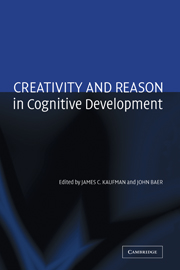Book contents
- Frontmatter
- Contents
- List of Contributors
- Acknowledgments
- Creativity and Reason in Cognitive Development
- Introduction
- COGNITIVE PERSPECTIVES
- DEVELOPMENTAL AND EDUCATIONAL PERSPECTIVES
- 12 Creativity in Young Children's Thought
- 13 A Young Artist's Story: Advancing Knowledge and the Development of Artistic Talent and Creativity in Children
- 14 Is It Reasonable to Be Creative?
- 15 Does Culture Always Matter: For Creativity, Yes, for Deductive Reasoning, No!
- 16 Higher Level Thinking in Gifted Education
- 17 The Relationship Among Schooling, Learning, and Creativity: “All Roads Lead to Creativity” or “You Can't Get There from Here”?
- 18 How Early School Experiences Impact Creativity: An Ecological Perspective
- 19 Conclusions
- Author Index
- Subject Index
- References
13 - A Young Artist's Story: Advancing Knowledge and the Development of Artistic Talent and Creativity in Children
Published online by Cambridge University Press: 19 January 2010
- Frontmatter
- Contents
- List of Contributors
- Acknowledgments
- Creativity and Reason in Cognitive Development
- Introduction
- COGNITIVE PERSPECTIVES
- DEVELOPMENTAL AND EDUCATIONAL PERSPECTIVES
- 12 Creativity in Young Children's Thought
- 13 A Young Artist's Story: Advancing Knowledge and the Development of Artistic Talent and Creativity in Children
- 14 Is It Reasonable to Be Creative?
- 15 Does Culture Always Matter: For Creativity, Yes, for Deductive Reasoning, No!
- 16 Higher Level Thinking in Gifted Education
- 17 The Relationship Among Schooling, Learning, and Creativity: “All Roads Lead to Creativity” or “You Can't Get There from Here”?
- 18 How Early School Experiences Impact Creativity: An Ecological Perspective
- 19 Conclusions
- Author Index
- Subject Index
- References
Summary
In contemporary Western cultures, children's artistic exceptionality is often characterized by the expressiveness and formal boldness of the young child's work, reflecting the value placed on these particular characteristics by the modern masters (e.g., Kandinsky, Klee, and Picasso) (Fineberg, 1997). Thus the conventional rules that modern artists themselves sought to overcome are the very things modern educators have thought it imperative to withhold from young children (Viola, 1936) – all in the name of fomenting a “natural” creativity. In taking on these more complex ways of thinking, however – thinking supported by children acquiring advanced knowledge of artistic conventions and experience – do they have to lose creativity? Or, can acquiring the conventions of the visual arts domain actually enhance the development of a child's creativity?
Studies of drawings by young art students, nonart students, and children who realized their potential for artistic giftedness in adulthood (Rostan, 1997, 1998, in press; Rostan, Pariser, & Gruber, 2002) provide clear evidence regarding the effects of advancing knowledge on the development of artistic talent and creativity in children. Focusing on the nature of this artistic experience and developing expertise, this chapter argues that artistic creativity does emerge from measurable interactions between advancing knowledge and visual information processing. Furthermore, the relationships among advanced knowledge in the visual arts, the processing of visual information (i.e., problem finding and reasoning), and creative productivity depend on the task, the behavior monitored, the phase of developing talent, and the expertise that educational intervention can afford.
- Type
- Chapter
- Information
- Creativity and Reason in Cognitive Development , pp. 244 - 268Publisher: Cambridge University PressPrint publication year: 2006
References
- 2
- Cited by

